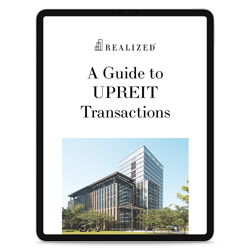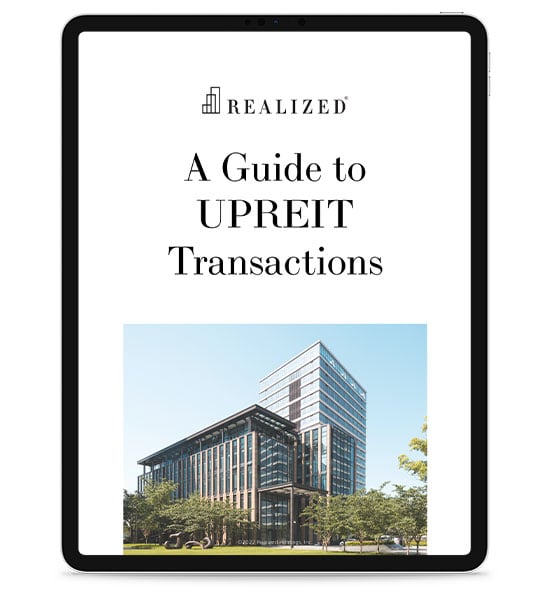
Private and publicly traded real estate investment trusts (REITs) both focus on the ownership, financing, and operation of commercial real estate, but many of the similarities end there.
Both types of REITs must adhere to a strict set of rules established by the IRS that govern their operations, mainly that 75 percent of the REIT’s income is derived from real estate leases or the sale of real property, and that they distribute a minimum of 90 percent of taxable income back to shareholders in the form of taxable dividends.
There are many other shared covenants, but there also are some distinct differences between public and private REITs. This article examines key differentiations between the two types of real estate investment trusts.
Private REITs versus Public REITs
Although the majority of REITs are public – there are more than 225 REITs trading on public exchanges, namely the New York Stock Exchange¹ – they all started out as private REITs.
Real estate investment trusts were established in 1960 after President Eisenhower signed into law the Cigar Excise Tax Extension Act.² That year and into the following, the first six REITs were created, and three of them are still operating. Newly formed REITs are private entities that often start out as property management firms before morphing into REITs as they grow their portfolio of real property assets under management.
In order to secure and maintain REIT status, private REITs must have 100 or more shareholders by their first year, and 50 percent of the company’s shares cannot be held by five or fewer people after the first year. Unlike publicly-traded REITs, whose shares can be purchased and divested at will, making them highly liquid investments, private REITs are considered highly illiquid investments since investors typically can only access their money once the REIT lists its shares on a public exchange or winds down operations by divesting its portfolio of commercial real estate assets. These exit strategies can take up to a decade depending on the REIT’s business model, making them unfit for investors with shorter investment horizons. Investors who want or need to liquidate their shares prior to these common private REIT exit strategies often face difficult or limited share redemption programs, if they exist at all.
There are other key differences as well. In addition to management fees, most private REITs have multiple layers of additional fees that can adversely affect the strength of potential dividends. Publicly traded REITs also are required to file regular reports with the Securities and Exchange Commission that can give prospective investors important insight into the company’s cash flow, properties under management, investment strategies, historical performance, and track record of the management team. Private REITs aren’t regulated by the SEC so they are not bound by these same requirements. As a result, investors oftentimes can find little public information or independent assessment of the performance of private REITs.
Another key difference between private and public REITs is availability. More than 145 million Americans have public REIT stock in their investment or retirement portfolios. Private REITs, meanwhile, are available only to institutional investors such as hedge, pension, and endowment funds and insurance companies or accredited solo investors with a net worth of $1 million and annual income north of $200,000.
The Bottom Line
Private and public REITs typically focus on one sector of commercial real estate, such as hospitality, senior housing, multifamily, office, or industrial. Shares of private REITs are typically offered by brokers or financial advisers to institutional and accredited investors. They are highly illiquid, long-term investments that issue little to no public guidance or performance metrics. Benefits include the potential for higher dividend yields, lack of correlation to market swings, and lower compliance costs. Potential cons include increased investment risk, lack of transparency, higher commissions and other fees, and illiquidity.
Investors considering private REITs should carefully examine the company’s prospectus to determine how the fee structure will impact their investment, as well as gauge the management team experience and other important details to determine if the investment aligns with their strategies and tolerance for risk.
Sources:
1. FAQ About REITs, Nareit, https://www.reit.com/what-reit/frequently-asked-questions-about-reits
2. REITs Through the Years, Nareit, https://thereitway.com/reits-through-the-years/
This material is for general information and educational purposes only. Information is based on data gathered from what we believe are reliable sources. It is not guaranteed as to accuracy, does not purport to be complete and is not intended to be used as a primary basis for investment decisions. It should also not be construed as advice meeting the particular investment needs of any investor. Realized does not provide tax or legal advice. This material is not a substitute for seeking the advice of a qualified professional for your individual situation.
Costs associated with a 1031 transaction may impact investor’s returns and may outweigh the tax benefits. An unfavorable tax ruling may cancel deferral of capital gains and result in immediate tax liabilities. All investments have an inherent level of risk. The value of your investment will fluctuate with the value of the underlying investments. You could receive back less than you initially invested and there is no guarantee that you will receive any income. There is no guarantee that companies that can issue dividends will declare, continue to pay, or increase dividends. A REIT is a security that sells like a stock on the major exchanges and invests in real estate directly, either through properties or mortgages. REITs receive special tax considerations and typically offer investors high yields, as well as a highly liquid method of investing in real estate. There are risks associated with these types of investments and include but are not limited to the following: Typically no secondary market exists for the security listed above. Potential difficulty discerning between routine interest payments and principal repayment. Redemption price of a REIT may be worth more or less than the original price paid. Value of the shares in the trust will fluctuate with the portfolio of underlying real estate. Involves risks such as refinancing in the real estate industry, interest rates, availability of mortgage funds, operating expenses, cost of insurance, lease terminations, potential economic and regulatory changes. This is neither an offer to sell nor a solicitation or an offer to buy the securities described herein. The offering is made only by the Prospectus.



